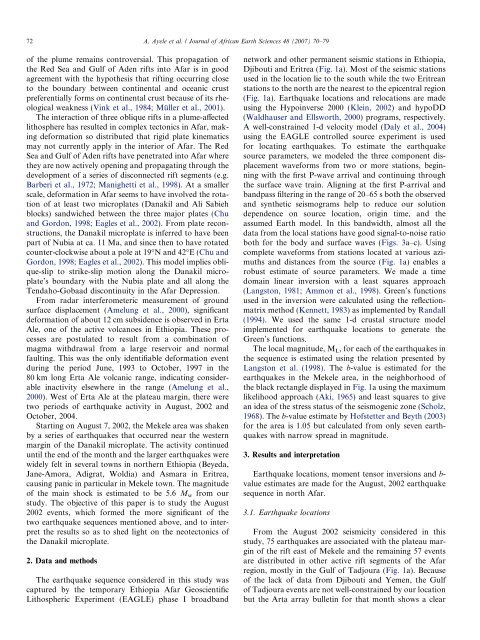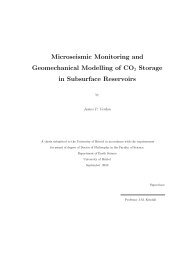The August 2002 earthquake sequence in north Afar: Insights into ...
The August 2002 earthquake sequence in north Afar: Insights into ...
The August 2002 earthquake sequence in north Afar: Insights into ...
You also want an ePaper? Increase the reach of your titles
YUMPU automatically turns print PDFs into web optimized ePapers that Google loves.
72 A. Ayele et al. / Journal of African Earth Sciences 48 (2007) 70–79<br />
of the plume rema<strong>in</strong>s controversial. This propagation of<br />
the Red Sea and Gulf of Aden rifts <strong>in</strong>to <strong>Afar</strong> is <strong>in</strong> good<br />
agreement with the hypothesis that rift<strong>in</strong>g occurr<strong>in</strong>g close<br />
to the boundary between cont<strong>in</strong>ental and oceanic crust<br />
preferentially forms on cont<strong>in</strong>ental crust because of its rheological<br />
weakness (V<strong>in</strong>k et al., 1984; Müller et al., 2001).<br />
<strong>The</strong> <strong>in</strong>teraction of three oblique rifts <strong>in</strong> a plume-affected<br />
lithosphere has resulted <strong>in</strong> complex tectonics <strong>in</strong> <strong>Afar</strong>, mak<strong>in</strong>g<br />
deformation so distributed that rigid plate k<strong>in</strong>ematics<br />
may not currently apply <strong>in</strong> the <strong>in</strong>terior of <strong>Afar</strong>. <strong>The</strong> Red<br />
Sea and Gulf of Aden rifts have penetrated <strong>in</strong>to <strong>Afar</strong> where<br />
they are now actively open<strong>in</strong>g and propagat<strong>in</strong>g through the<br />
development of a series of disconnected rift segments (e.g.<br />
Barberi et al., 1972; Manighetti et al., 1998). At a smaller<br />
scale, deformation <strong>in</strong> <strong>Afar</strong> seems to have <strong>in</strong>volved the rotation<br />
of at least two microplates (Danakil and Ali Sabieh<br />
blocks) sandwiched between the three major plates (Chu<br />
and Gordon, 1998; Eagles et al., <strong>2002</strong>). From plate reconstructions,<br />
the Danakil microplate is <strong>in</strong>ferred to have been<br />
part of Nubia at ca. 11 Ma, and s<strong>in</strong>ce then to have rotated<br />
counter-clockwise about a pole at 19°N and 42°E (Chu and<br />
Gordon, 1998; Eagles et al., <strong>2002</strong>). This model implies oblique-slip<br />
to strike-slip motion along the Danakil microplate’s<br />
boundary with the Nubia plate and all along the<br />
Tendaho-Gobaad discont<strong>in</strong>uity <strong>in</strong> the <strong>Afar</strong> Depression.<br />
From radar <strong>in</strong>terferometeric measurement of ground<br />
surface displacement (Amelung et al., 2000), significant<br />
deformation of about 12 cm subsidence is observed <strong>in</strong> Erta<br />
Ale, one of the active volcanoes <strong>in</strong> Ethiopia. <strong>The</strong>se processes<br />
are postulated to result from a comb<strong>in</strong>ation of<br />
magma withdrawal from a large reservoir and normal<br />
fault<strong>in</strong>g. This was the only identifiable deformation event<br />
dur<strong>in</strong>g the period June, 1993 to October, 1997 <strong>in</strong> the<br />
80 km long Erta Ale volcanic range, <strong>in</strong>dicat<strong>in</strong>g considerable<br />
<strong>in</strong>activity elsewhere <strong>in</strong> the range (Amelung et al.,<br />
2000). West of Erta Ale at the plateau marg<strong>in</strong>, there were<br />
two periods of <strong>earthquake</strong> activity <strong>in</strong> <strong>August</strong>, <strong>2002</strong> and<br />
October, 2004.<br />
Start<strong>in</strong>g on <strong>August</strong> 7, <strong>2002</strong>, the Mekele area was shaken<br />
by a series of <strong>earthquake</strong>s that occurred near the western<br />
marg<strong>in</strong> of the Danakil microplate. <strong>The</strong> activity cont<strong>in</strong>ued<br />
until the end of the month and the larger <strong>earthquake</strong>s were<br />
widely felt <strong>in</strong> several towns <strong>in</strong> <strong>north</strong>ern Ethiopia (Beyeda,<br />
Jane-Amora, Adigrat, Woldia) and Asmara <strong>in</strong> Eritrea,<br />
caus<strong>in</strong>g panic <strong>in</strong> particular <strong>in</strong> Mekele town. <strong>The</strong> magnitude<br />
of the ma<strong>in</strong> shock is estimated to be 5.6 M w from our<br />
study. <strong>The</strong> objective of this paper is to study the <strong>August</strong><br />
<strong>2002</strong> events, which formed the more significant of the<br />
two <strong>earthquake</strong> <strong>sequence</strong>s mentioned above, and to <strong>in</strong>terpret<br />
the results so as to shed light on the neotectonics of<br />
the Danakil microplate.<br />
2. Data and methods<br />
<strong>The</strong> <strong>earthquake</strong> <strong>sequence</strong> considered <strong>in</strong> this study was<br />
captured by the temporary Ethiopia <strong>Afar</strong> Geoscientific<br />
Lithospheric Experiment (EAGLE) phase I broadband<br />
network and other permanent seismic stations <strong>in</strong> Ethiopia,<br />
Djibouti and Eritrea (Fig. 1a). Most of the seismic stations<br />
used <strong>in</strong> the location lie to the south while the two Eritrean<br />
stations to the <strong>north</strong> are the nearest to the epicentral region<br />
(Fig. 1a). Earthquake locations and relocations are made<br />
us<strong>in</strong>g the Hypo<strong>in</strong>verse 2000 (Kle<strong>in</strong>, <strong>2002</strong>) and hypoDD<br />
(Waldhauser and Ellsworth, 2000) programs, respectively.<br />
A well-constra<strong>in</strong>ed 1-d velocity model (Daly et al., 2004)<br />
us<strong>in</strong>g the EAGLE controlled source experiment is used<br />
for locat<strong>in</strong>g <strong>earthquake</strong>s. To estimate the <strong>earthquake</strong><br />
source parameters, we modeled the three component displacement<br />
waveforms from two or more stations, beg<strong>in</strong>n<strong>in</strong>g<br />
with the first P-wave arrival and cont<strong>in</strong>u<strong>in</strong>g through<br />
the surface wave tra<strong>in</strong>. Align<strong>in</strong>g at the first P-arrival and<br />
bandpass filter<strong>in</strong>g <strong>in</strong> the range of 20–65 s both the observed<br />
and synthetic seismograms help to reduce our solution<br />
dependence on source location, orig<strong>in</strong> time, and the<br />
assumed Earth model. In this bandwidth, almost all the<br />
data from the local stations have good signal-to-noise ratio<br />
both for the body and surface waves (Figs. 3a–c). Us<strong>in</strong>g<br />
complete waveforms from stations located at various azimuths<br />
and distances from the source (Fig. 1a) enables a<br />
robust estimate of source parameters. We made a time<br />
doma<strong>in</strong> l<strong>in</strong>ear <strong>in</strong>version with a least squares approach<br />
(Langston, 1981; Ammon et al., 1998). Green’s functions<br />
used <strong>in</strong> the <strong>in</strong>version were calculated us<strong>in</strong>g the reflectionmatrix<br />
method (Kennett, 1983) as implemented by Randall<br />
(1994). We used the same 1-d crustal structure model<br />
implemented for <strong>earthquake</strong> locations to generate the<br />
Green’s functions.<br />
<strong>The</strong> local magnitude, M L , for each of the <strong>earthquake</strong>s <strong>in</strong><br />
the <strong>sequence</strong> is estimated us<strong>in</strong>g the relation presented by<br />
Langston et al. (1998). <strong>The</strong> b-value is estimated for the<br />
<strong>earthquake</strong>s <strong>in</strong> the Mekele area, <strong>in</strong> the neighborhood of<br />
the black rectangle displayed <strong>in</strong> Fig. 1a us<strong>in</strong>g the maximum<br />
likelihood approach (Aki, 1965) and least squares to give<br />
an idea of the stress status of the seismogenic zone (Scholz,<br />
1968). <strong>The</strong> b-value estimate by Hofstetter and Beyth (2003)<br />
for the area is 1.05 but calculated from only seven <strong>earthquake</strong>s<br />
with narrow spread <strong>in</strong> magnitude.<br />
3. Results and <strong>in</strong>terpretation<br />
Earthquake locations, moment tensor <strong>in</strong>versions and b-<br />
value estimates are made for the <strong>August</strong>, <strong>2002</strong> <strong>earthquake</strong><br />
<strong>sequence</strong> <strong>in</strong> <strong>north</strong> <strong>Afar</strong>.<br />
3.1. Earthquake locations<br />
From the <strong>August</strong> <strong>2002</strong> seismicity considered <strong>in</strong> this<br />
study, 75 <strong>earthquake</strong>s are associated with the plateau marg<strong>in</strong><br />
of the rift east of Mekele and the rema<strong>in</strong><strong>in</strong>g 57 events<br />
are distributed <strong>in</strong> other active rift segments of the <strong>Afar</strong><br />
region, mostly <strong>in</strong> the Gulf of Tadjoura (Fig. 1a). Because<br />
of the lack of data from Djibouti and Yemen, the Gulf<br />
of Tadjoura events are not well-constra<strong>in</strong>ed by our location<br />
but the Arta array bullet<strong>in</strong> for that month shows a clear











